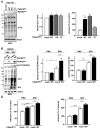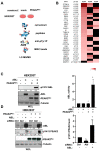Oncogenic Signalling of PEAK2 Pseudokinase in Colon Cancer
- PMID: 35740644
- PMCID: PMC9221080
- DOI: 10.3390/cancers14122981
Oncogenic Signalling of PEAK2 Pseudokinase in Colon Cancer
Abstract
The PEAK family pseudokinases are essential components of tyrosine kinase (TK) pathways that regulate cell growth and adhesion; however, their role in human cancer remains unclear. Here, we report an oncogenic activity of the pseudokinase PEAK2 in colorectal cancer (CRC). Notably, high PRAG1 expression, which encodes PEAK2, was associated with a bad prognosis in CRC patients. Functionally, PEAK2 depletion reduced CRC cell growth and invasion in vitro, while its overexpression increased these transforming effects. PEAK2 depletion also reduced CRC development in nude mice. Mechanistically, PEAK2 expression induced cellular protein tyrosine phosphorylation, despite its catalytic inactivity. Phosphoproteomic analysis identified regulators of cell adhesion and F-actin dynamics as PEAK2 targets. Additionally, PEAK2 was identified as a novel ABL TK activator. In line with this, PEAK2 expression localized at focal adhesions of CRC cells and induced ABL-dependent formation of actin-rich plasma membrane protrusions filopodia that function to drive cell invasion. Interestingly, all these PEAK2 transforming activities were regulated by its main phosphorylation site, Tyr413, which implicates the SRC oncogene. Thus, our results uncover a protumoural function of PEAK2 in CRC and suggest that its deregulation affects adhesive properties of CRC cells to enable cancer progression.
Keywords: actin cytoskeleton; cell migration; cell signalling; colorectal cancer; oncogene; phosphoproteomic; pseudokinase.
Conflict of interest statement
The authors declare no conflict of interest.
Figures







References
-
- Yaeger R., Chatila W.K., Lipsyc M.D., Hechtman J.F., Cercek A., Sanchez-Vega F., Jayakumaran G., Middha S., Zehir A., Donoghue M.T.A., et al. Clinical Sequencing Defines the Genomic Landscape of Metastatic Colorectal Cancer. Cancer Cell. 2018;33:125–136.e3. doi: 10.1016/j.ccell.2017.12.004. - DOI - PMC - PubMed
Grants and funding
LinkOut - more resources
Full Text Sources
Research Materials
Miscellaneous

